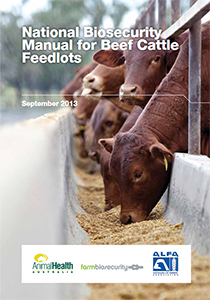The National Biosecurity Manual for Beef Cattle Feedlots has been produced as a tool that owners, managers, staff and contractors at beef cattle feedlots can use to translate biosecurity practices into operating procedures and work instructions.
Farm biosecurity is a set of measures that can be put in place to prevent diseases, pests and weeds from coming onto your property, and to effectively deal with them should they arrive.
You have an important role to play in protecting your property and the entire lot feeding industry from biosecurity threats. At the industry, regional and national levels, biosecurity measures protect the health of livestock, limit production losses and help maintain market access for Australia’s lot feeders.
On this page, you will find the tools to implement the simple, everyday biosecurity practices to help you secure your farm and secure your future.

The National Biosecurity Manual for Beef Cattle Feedlots has been produced as a tool that owners, managers, staff and contractors at beef cattle feedlots can use to translate biosecurity practices into operating procedures and work instructions.
As a lot feeder, the number one way to protect yourself from biosecurity risks is to keep diseases, pests and weeds off your property.
Always insist on a properly completed Cattle Health Declaration when purchasing stock, offering cattle for sale, and when mandated by inter-state movement requirements.
Biosecurity standards, as identified in the industry’s biosecurity plan, form an important component of the National Feedlot Accreditation Scheme (NFAS), the quality assurance program (QA) for Australian feedlots.
The Australian Lot Feeders’ Association has pioneered on-farm quality assurance in the livestock industries, including strict compliance checking with government endorsed animal welfare standards.
The single biggest threat to the lot feeding industry’s sustainability is an outbreak of an emergency animal disease. That’s why the Australian Lot Feeders’ Association has put into place a series of animal health policies at both the state and national levels to guard against threats to the industry’s biosecurity.
Australia’s National Livestock Identification System (NLIS) identifies animals so that we can trace them quickly if we need to. It applies to anyone with cattle, sheep, pigs or goats.
If there is an outbreak of an emergency disease (for example foot and mouth disease), we can quickly trace back to identify animals that might already be infected, and trace forward to identify animals that are at the greatest risk of infection.
For more information read more about emergency animal diseases.